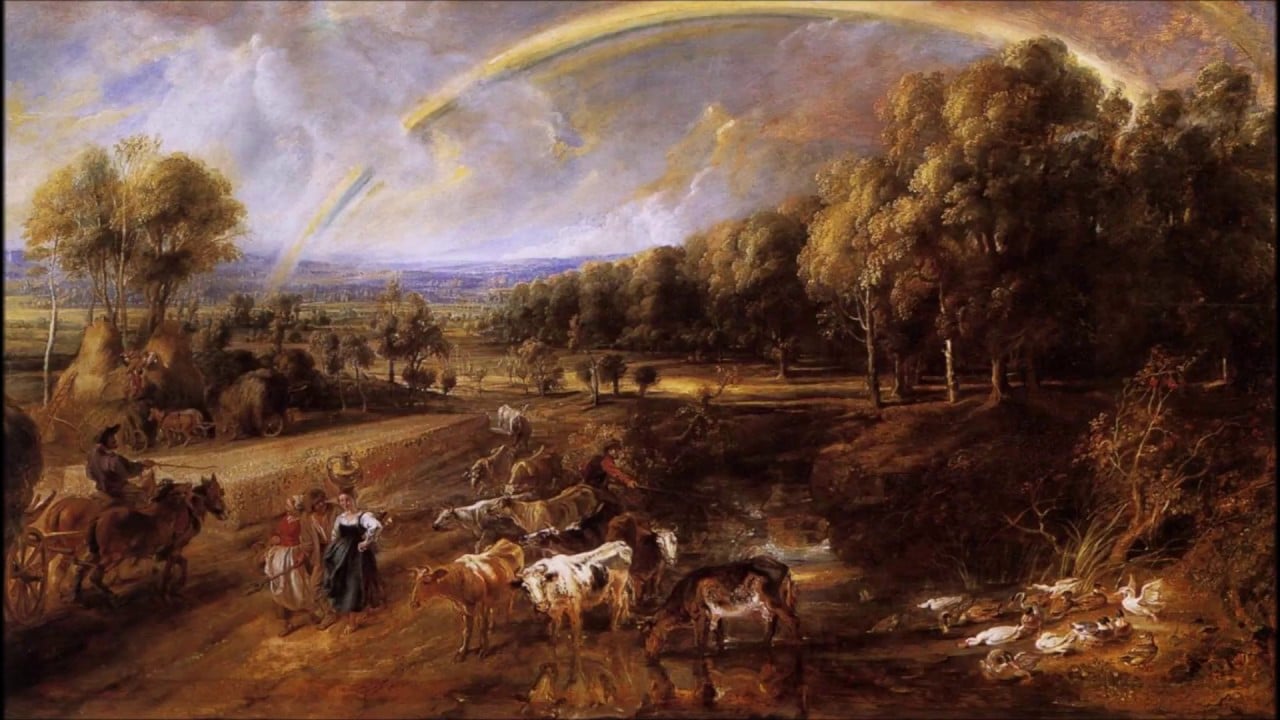Painting, graphic art, and sculpture produced in an area similar in size to that of modern Belgium and Luxembourg, formerly known as the Southern Netherlands. Flemish art assumed a major role in the history of European art during the 15th, 16th, and 17th centuries. The largest county in the Southern Netherlands was Flanders and the term Flanders may be used to refer to the whole of the Southern Netherlands, just as Holland has often given its name to the whole of the Northern Netherlands.
Flemish art should describe art produced only in the county of Flanders, but the term is used to describe work carried out over a wider region, including neighbouring Brabant, Hainaut, Picardy, and Artois, the last two now part of France. Although small, in the Middle Ages these areas lay between the powerful kingdoms of England, France, and the Holy Roman Empire and were densely populated and economically prosperous, because of their advantageous geographical location close to the sea. Through an excellent system of waterways linking them to the sea and a close trading relationship with England, the Flemish cities of Bruges and Ghent became economically prosperous centres of the wool trade in the 15th century. Wool produced from English sheep was woven by Flemish weavers and then sold at fairs and exported to other European cities.
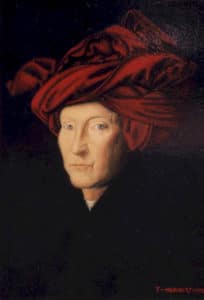 Little survives of Flemish art before the 14th century. The earliest examples are fragmentary and of unknown origin. In Tournai Cathedral there are wall paintings which survive from the early 13th century and in the Onze Lieve Vrouwkerk (church of Our Lady), Bruges, there are a number of painted tombs dating from the 13th and 14th centuries. They depict the Madonna and Child, saints, and angels painted in a strong, black outline style, with the details of drapery and facial features shaded in yellow and red earth colours. There are further wall paintings in Bijloke Abbey, Ghent, dating from about 1350, which show a strong French Gothic influence in the elegant drapery patterns and naturalistic details.
Little survives of Flemish art before the 14th century. The earliest examples are fragmentary and of unknown origin. In Tournai Cathedral there are wall paintings which survive from the early 13th century and in the Onze Lieve Vrouwkerk (church of Our Lady), Bruges, there are a number of painted tombs dating from the 13th and 14th centuries. They depict the Madonna and Child, saints, and angels painted in a strong, black outline style, with the details of drapery and facial features shaded in yellow and red earth colours. There are further wall paintings in Bijloke Abbey, Ghent, dating from about 1350, which show a strong French Gothic influence in the elegant drapery patterns and naturalistic details.
Towards the end of the 14th century the names of Flemish artists are increasingly documented working at the courts of France and Burgundy. One of the earliest was Jan Baudolf, also known as Jean de Bruges, active from about 1368 to 1381. In 1368 he became court painter to Charles V and designed the Angers Apocalyse tapestry series (c.1375; Angers, Tapestry Mus.). Such artistic ties became even stronger as a result of the marriage between Philip the Bold, first Duke of Burgundy, and Margaret, the daughter and heiress of Louis de Mâle, Count of Flanders, since, in 1384, Philip inherited the county of Flanders from his father-in-law. Philip the Bold became a notable patron of Flemish artists, commissioning them particularly for the decoration of his monastic foundation of the Charterhouse of Champmol, near Dijon, one of the foremost projects of the late Middle Ages. Except for some fragments of sculpture and a few carved and painted altarpieces, nothing remains of this magnificent enterprise. The main sculptor was Claus Sluter, whose surviving works such as the Well of Moses (in situ) or the tomb of Philip the Bold (Dijon, Mus. des Beaux-Arts) show a new dynamic realism in the powerful figures with their weighty draperies. Another artist involved in the decoration of the Charterhouse of Champmol was Melchior Broederlam. Only two large painted wings of a carved triptych (Dijon, Mus. des Beaux-Arts) survive, of which the central carved and gilded panels are by Jacques de Baerze, who was a Flemish woodcarver from Termonde, near Ghent. The wings by Broederlam are examples of what has now become known as the International Gothic style, in which typical Flemish attention to naturalistic detail is combined with Italian architectural forms reminiscent of Sienese painting and the weighty figure forms of Florentine painters such as Giotto. Flemish artists became known at this time as manuscript illuminators. John, Duke of Berry, younger brother of Philip the Bold, was an enthusiastic book collector and attracted Flemish artists to his court. Jacquemart de Hesdin became his court painter in 1402 and, in 1409, was replaced by the three brothers Limburg, who produced for the Duke the illuminations of the Très Riches Heures (Chantilly, Mus. Condé). The calendar pages, in particular, show an extraordinary understanding of landscape with cast shadows, reflections, and a feeling for atmosphere and weather conditions.
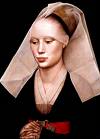 During the 15th century Flemish artists of outstanding ability proliferated. One of the first artists to develop both large- and small-scale religious altarpieces and the new subject of portraiture was Robert Campin, active in Tournai at the beginning of the century, who probably taught Rogier van der Weyden. Many art historians accept him as being synonymous with the unknown Master of Flémalle. Examples of his work are the Merode altarpiece (c.1425; New York, Met. Mus. Cloisters) and a pair of portraits of A Man and A Woman (London, NG). The powerful physicality of his figures, probably influenced by the sculpture of Sluter, demonstrate a new concern for realism. The figures, set within typical Flemish 15th-century interiors, are often dressed in contemporary clothes.
During the 15th century Flemish artists of outstanding ability proliferated. One of the first artists to develop both large- and small-scale religious altarpieces and the new subject of portraiture was Robert Campin, active in Tournai at the beginning of the century, who probably taught Rogier van der Weyden. Many art historians accept him as being synonymous with the unknown Master of Flémalle. Examples of his work are the Merode altarpiece (c.1425; New York, Met. Mus. Cloisters) and a pair of portraits of A Man and A Woman (London, NG). The powerful physicality of his figures, probably influenced by the sculpture of Sluter, demonstrate a new concern for realism. The figures, set within typical Flemish 15th-century interiors, are often dressed in contemporary clothes.
The Ghent altarpiece (1432; Ghent Cathedral), one of the most ambitious and complex altarpieces of northern European art, was created by Campin’s contemporaries, the brothers Hubert and Jan van Eyck. An inscription on the triptych, now thought to be original, describes Jodocus Vijd as the patron and Hubert as the brother who began the altarpiece, which was then finished by Jan. The influence of Sluter and Campin can clearly be seen on the closed front panels in the solid figures and sculptural draperies, but the glowing colours, the intensely realized depiction of jewels, and the golden light of the landscape of the inner panels represent a supremely novel contribution. After three years’ service with the Count of Holland, Jan van Eyck was appointed court painter to Philip the Good, Duke of Burgundy, in 1425 and undertook a number of diplomatic missions for him, travelling to Portugal, probably via England, to bring back the Infanta Isabella as Philip’s bride. Jan also worked for other leading patrons attached to the Burgundian court, including Nicolas Rolin, for whom he painted the Virgin and Child (Paris, Louvre). In the subtle definition of the textures of fabrics and jewels, together with the suggestive atmospheric space in the vast but detailed panoramic background, the altarpiece reveals Jan van Eyck’s mastery of the new technique of oil painting. Jan’s successors such as Petrus Christus and Dieric Bouts were influenced by his technical skill and powers of invention. Such developments not only brought Jan van Eyck international renown, as shown in the writings of Italian authors such as Bonifacio Fazio and Vasari, but also raised a general awareness of Flemish artists among Italian artists and patrons during the last half of the 15th century.
By the mid-15th century van Eyck’s position in Bruges was filled by Petrus Christus and other cities, such as Louvain where the Bouts family were the main painters, became important artistic centres. Another leading artist was Rogier van der Weyden. It is generally accepted that he was Campin’s pupil and in 1435 was appointed official painter to the city of Brussels. The dramatic power of Rogier’s work, as in the Deposition (Madrid, Prado), was achieved through his use of strong line and the portrayal of expressive emotions on the faces of his large, serious figures. Rogier shows a considerable restraint in his use of colour and his landscape background details are kept to a minimum, as in the Last Judgement (Beaune, Hôtel-Dieu).
Petrus Christus and Dieric Bouts were influenced by both Jan van Eyck and Rogier van der Weyden. Petrus Christus may have been responsible for completing a number of unfinished works by Jan van Eyck. His S. Eligius and Two Lovers (1446; New York, Met. Mus.) shows a debt to van Eyck in the gleaming details of the goldsmith’s shop and the convex mirror, which reflects the viewer’s space outside the painting, as in van Eyck’s earlier Arnolfini Portrait (1434; London, NG). On the other hand, another of Christus’ works, a Deposition (Brussels, Mus. Royaux) is, in its sculptural and linear form, reminiscent of van der Weyden’s work. In his portrait painting, Christus avoids the dark background of earlier pioneer portrait painters such as Campin, van Eyck, and van der Weyden and introduces window settings and finely detailed interiors, as in the portrait of Edward Grymstone (1446; London, NG).
Dieric Bouts, of Dutch origin from Haarlem, became the leading painter in the important university city of Louvain (Leuven). The wide diversity of patronage enjoyed by Flemish artists is exemplified by a number of his more important commissions such as the altarpiece of The Holy Sacrament (Louvain, S. Pierre) commissioned by the confraternity of the Holy Sacrament and the Justice of the Emperor Otto panels (Brussels, Mus. Royaux) painted for the courts of justice in Louvain Town Hall. Most Flemish painting which has survived is on wooden panel, but many altarpieces were painted on linen and have not survived in such numbers. Bouts’s Entombment (London, NG) is a fine and rare example of this delicate medium.
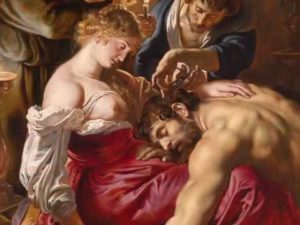 The remainder of the 15th century is dominated by Hans Memling and Gerard David in Bruges, and Hugo van der Goes in Ghent. Memling’s peaceful, balanced altarpieces, such as the triptych (London, NG) commissioned by the English court official Sir John Donne, proved very influential and were sought after by both public and private patrons. An Italian merchant, Angelo Tani, commissioned a Last Judgement (Gdánsk, National Mus.). Intended for Italy, the altarpiece was part of booty taken by pirates. Another Italian patron, the Medici agent Tommaso Portinari, commissioned the Adoration of the Shepherds (Florence, Uffizi) by Hugo van der Goes. Soon after it was painted it was sent to Italy and contributed in the late 15th century towards the increasing impact of Flemish art on Italian Renaissance painters, such as Domenico Ghirlandaio and Piero della Francesca.
The remainder of the 15th century is dominated by Hans Memling and Gerard David in Bruges, and Hugo van der Goes in Ghent. Memling’s peaceful, balanced altarpieces, such as the triptych (London, NG) commissioned by the English court official Sir John Donne, proved very influential and were sought after by both public and private patrons. An Italian merchant, Angelo Tani, commissioned a Last Judgement (Gdánsk, National Mus.). Intended for Italy, the altarpiece was part of booty taken by pirates. Another Italian patron, the Medici agent Tommaso Portinari, commissioned the Adoration of the Shepherds (Florence, Uffizi) by Hugo van der Goes. Soon after it was painted it was sent to Italy and contributed in the late 15th century towards the increasing impact of Flemish art on Italian Renaissance painters, such as Domenico Ghirlandaio and Piero della Francesca.
In the 16th century Antwerp, on the river Scheldt, became the major port, superseding Bruges and Ghent whose canals had begun to silt up and were no longer capable of accommodating the larger ships needed for trade with the New World. It became a city of outstanding economic importance, as well as a centre of cartography, printing, and art. Antwerp’s printing presses spread the new ideas of humanist scholars such as Erasmus, and printmaking became an influential art form of mass communication. At the same time a greater variety of subject matter such as landscape, genre, and still life appeared in painting and Flemish artists became more aware of ideas from Renaissance Italy. The work of Quentin Massys in Antwerp at the beginning of the 16th century epitomizes these characteristics. His large triptychs such as his S. Anne altarpiece (Brussels, Mus. Royaux) for the confraternity of the archers’ guild of Louvain, with its monumental figures and classicizing architecture, may reveal Massys’s knowledge of the work of Italian artists such as Leonardo da Vinci. Massys contributed to the development of genre painting, for example in the Moneylender and his Wife (Paris, Louvre). This development made an important impact on his contemporaries such Joos van Cleve, Jan Sanders van Hemessen, and Marinus van Reymerswaele. The Tax Gatherers (London, NG) by van Reymerswaele is typical of a continuing demand throughout the 16th century for such work.
Jan Gossaert was credited by the Netherlandish writer Karel van Mander in his influential Het schilderboeck, published in 1604, as the first painter to introduce from Italy to the Netherlands the painting of nude figures and mythological subjects. In 1508–9, whilst Michelangelo and Raphael were working for Pope Julius II in the Vatican, Gossaert visited Rome and Florence, where he made drawings of Antique sculpture. On returning to the Netherlands his compositions of Italianate nude figures, with somewhat exaggerated musculature, such as Venus and Cupid (1521; Brussels, Mus. Royaux), reveal the impact of his visit. Prints made after his work influenced his successors such as his pupil Jan van Scorel and Lambert Lombard, who taught the ‘Italian manner’ to the next generation of artists. Amongst these were Willem Key, Hendrik Goltzius, Maerten van Heemskerck, and Frans Floris. Floris visited Rome in 1541 and his Fall of the Rebel Angels (1554; Antwerp, Koninklijk Mus. voor Schone Kunsten) is indebted to Michelangelo’s Last Judgement (Vatican, Sistine chapel) which Floris saw there.
By the 16th century Brussels had become an important centre of tapestry production and, in 1516, Raphael’s cartoons were sent there to the workshop of Pieter Coecke van Aelst to be woven into tapestries. A number of Flemish artists saw them, among them Bernaert van Orley, who was employed as court painter by Margaret of Austria, the Regent of the Netherlands, and her successor Mary of Hungary. However, after 1530, his main occupation seems to have been the designing of tapestries and stained-glass windows, such as the transept windows of S. Gudule, Brussels.
A highly individual, vigorous Mannerist style developed in Flanders towards the end of the 16th century. This may be seen in the work of Hendrick de Clerck and Bartholomäus Spranger. Spranger was one of a number of Flemish artists, including the painters Jan Brueghel and Roelandt Savery and the goldsmith and draughtsman Paulus van Vianen, who were invited to the Emperor Rudolf II’s court in Prague.
Flemish portraiture was dominated during the 16th century by the Pourbus family. Frans Pourbus the younger was one of the leading court portrait painters of Europe. He worked first at the court in Brussels and subsequently, 1600–9, he was employed by Duke Vincenzo Gonzaga I in Mantua. In 1609 Marie de Médicis summoned him to Paris, where he became her court portrait painter up to the time of his death. A meticulous handling of jewellery and sumptuous fabrics, as in Pourbus’ Archduchess Éléonore (1604; Vienna, Kunsthist. Mus.), are typical Flemish characteristics sought after by courtly sitters.
landscape painting emerged as an independent subject during the 16th century. Joachim Patinir and his followers, such as Cornelis Massys and Herri met de Bles, are early exponents of pure landscape. Landscape backgrounds had always been an important ingredient of the work of earlier Flemish painters such as Jan van Eyck and Hugo van der Goes, but Patinir’s work such as Flight into Egypt (Antwerp, Koninklijk Mus. voor Schone Kunsten) shows a new relationship between the figures and the surrounding natural world. Patinir may have been influenced by the panoramic vistas painted by his contemporaries Quentin Massys and the Dutch painter Hieronymus Bosch. Throughout the 16th century, painters were influenced by Patinir’s Weltlandschaften (world landscapes). His compositions of vast imaginary vistas of rocky mountains, woods, and pastures with their bird’s-eye viewpoint and three-tier colour system gave a new direction which influenced the rest of the century.
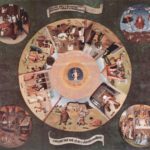 landscape and genre were developed further as independent subjects in the work of Pieter Bruegel the elder and his two sons, Pieter Bruegel the younger and Jan the elder. Pieter Bruegel’s place and date of birth are uncertain, but he joined the Antwerp guild in 1551/2, leaving for Italy soon after but returning again to Antwerp in 1555. His early work seems to have been as a printmaker, first for the Antwerp printer Hieronymus Cock. His compositions, such as the Seven Deadly Sins, were at first strongly influenced by Hieronymus Bosch, whose work was enjoying a fashionable revival. The Alpine landscape through which Bruegel passed on his travels remained a constant inspiration and contributed to a remarkable and influential series of landscape prints inspired by his pen and ink drawings such as Alpine Landscape (Paris, Louvre). His concern with space and atmosphere were to make a lasting impact on his contemporaries, both Flemish and Dutch, including his own son Jan Brueghel, Joost de Momper, and even Rubens. Upon his marriage to the daughter of his teacher Pieter Coecke van Aelst and his subsequent move to Brussels, Bruegel turned to painting for the remainder of his short career. Compositions of many small figures engaged in all manner of activities such as Netherlandish Proverbs (Berlin, Gemäldegal.) give way to fewer larger figures painted in simple blocks of colour in which red and green predominate, such as Village Wedding or Village Holiday (both Vienna, Kunsthist. Mus.). Among Bruegel’s patrons were some of the leading scholars and humanists, for example the cartographer Ortelius, or the wealthy connoisseur Nicolaas Jonghelinck, whose taste for landscape Bruegel satisfied with the series of the Seasons (1566; New York, Met. Mus.; Vienna, Kunsthist. Mus.; Nelahozeves, Lobkowicz Coll.). Genre and still life were also developed by Bruegel’s contemporaries, the Dutch-born Pieter Aertsen and Joachim Bueckelaer, whose workshop in Antwerp produced influential large-scale compositions sometimes of pure still life such as Aertsen’s Butcher’s Shop (1551; Uppsala, University Art Coll.), or more usually combined with monumental genre figures such as Bueckelaer’s Market Woman with Fruit and Vegetables (1554; Kassel, Staatliche Kunstsammlungen). Through prints these compositions influenced Spanish painters such as Velázquez or the Italian painters Vincenzo Campi, Passarotti, and Annibale Carracci.
landscape and genre were developed further as independent subjects in the work of Pieter Bruegel the elder and his two sons, Pieter Bruegel the younger and Jan the elder. Pieter Bruegel’s place and date of birth are uncertain, but he joined the Antwerp guild in 1551/2, leaving for Italy soon after but returning again to Antwerp in 1555. His early work seems to have been as a printmaker, first for the Antwerp printer Hieronymus Cock. His compositions, such as the Seven Deadly Sins, were at first strongly influenced by Hieronymus Bosch, whose work was enjoying a fashionable revival. The Alpine landscape through which Bruegel passed on his travels remained a constant inspiration and contributed to a remarkable and influential series of landscape prints inspired by his pen and ink drawings such as Alpine Landscape (Paris, Louvre). His concern with space and atmosphere were to make a lasting impact on his contemporaries, both Flemish and Dutch, including his own son Jan Brueghel, Joost de Momper, and even Rubens. Upon his marriage to the daughter of his teacher Pieter Coecke van Aelst and his subsequent move to Brussels, Bruegel turned to painting for the remainder of his short career. Compositions of many small figures engaged in all manner of activities such as Netherlandish Proverbs (Berlin, Gemäldegal.) give way to fewer larger figures painted in simple blocks of colour in which red and green predominate, such as Village Wedding or Village Holiday (both Vienna, Kunsthist. Mus.). Among Bruegel’s patrons were some of the leading scholars and humanists, for example the cartographer Ortelius, or the wealthy connoisseur Nicolaas Jonghelinck, whose taste for landscape Bruegel satisfied with the series of the Seasons (1566; New York, Met. Mus.; Vienna, Kunsthist. Mus.; Nelahozeves, Lobkowicz Coll.). Genre and still life were also developed by Bruegel’s contemporaries, the Dutch-born Pieter Aertsen and Joachim Bueckelaer, whose workshop in Antwerp produced influential large-scale compositions sometimes of pure still life such as Aertsen’s Butcher’s Shop (1551; Uppsala, University Art Coll.), or more usually combined with monumental genre figures such as Bueckelaer’s Market Woman with Fruit and Vegetables (1554; Kassel, Staatliche Kunstsammlungen). Through prints these compositions influenced Spanish painters such as Velázquez or the Italian painters Vincenzo Campi, Passarotti, and Annibale Carracci.
During the last quarter of the 16th century there is a decline in Flemish art brought on by the political unrest between the northern and southern parts of the Netherlands. Much religious art was destroyed in the ensuing iconoclasm and many Flemish artists left the Southern Netherlands for Rome, central Europe, or the Dutch Republic to find a more conducive environment for their work. Landscape painters such as Gillis van Coninxloo, who arrived in Amsterdam in 1595, or the Bril brothers who went to Rome, carried with them new ideas of landscape painting, whilst Ambrosius Bosschaert introduced Flemish ideas of still life to the Dutch Republic. By 1609 and the much needed respite provided by the Twelve Year Truce, Flemish art once again enjoyed a revival and the first half of the 17th century is dominated by the careers of three artists, Pieter Paul Rubens, Anthony van Dyck, and Jacob Jordaens. Religious art in particular was much in demand under the influence of the Counter-Reformation. It was injected with a new vigour by renewed influences from Italy through the work of Rubens who, after eight years in Italy, returned to Antwerp in 1608 with an already established reputation. Two of his early works, The Raising of the Cross, painted for S. Walburga, but now in the Cathedral, and The Deposition (Antwerp Cathedral), were important public commissions and established his position as the leading exponent of the Baroque in Europe. Although he remained in Antwerp as court painter to the Spanish rulers of the Southern Netherlands, Rubens’s visits on their behalf as diplomat to foreign courts enhanced his reputation as an artist and gained him commissions from the foremost patrons of his day. For the English King Charles I (see London), Rubens provided canvases for the newly completed Banqueting House (London, Whitehall) and for the French Queen Marie de Médicis (see Paris), an extensive series celebrating her career (Paris, Louvre). Many Flemish painters were involved in Rubens’s workshop, either as specialists in landscape or still life, such as Lucas van Uden and Jan Brueghel, or as assistants such as the young van Dyck, who carried out the major part of the 39 ceiling paintings and altarpiece for the Jesuit Church, Antwerp (destr.; existing only in oil sketches by Rubens in various collections). Rubens’s artistic abilities were also outstanding in the fields of portraiture and landscape. His early portraits for the Genoese nobility, such as Brigida Spinola Doria (Washington, NG), established a type of full-length portrait, to be followed so successfully by van Dyck in his many portraits in Genoa and in London. Rubens’s enthusiasm for the traditional Flemish subject of landscape was reawakened by the purchase of a country house, immortalized in Landscape with Château de Steen (London, NG).
Although van Dyck was influenced by Rubens he stands out in his own right, particularly in the field of portraiture. His early portraits, such as Elena Grimaldi (Washington, NG) combined elegance and grandeur with livelier and sensitive feeling for character. His portraits, such as the Children of Charles I (London, Royal Coll.), not only contributed to his success at the English court, but also provided a permanent image of the Stuarts which survives until today. They contributed to the future of portrait painting in Britain and had a lasting influence on British painters such as Gainsborough and Reynolds in the following century.
Jacob Jordaens painted religious and mythological works as well as portraits. Much admired are his exuberant genre scenes, for example As the Old Sing, so the Young Twitter (1638; Antwerp, Koninklijk Mus. voor Schone Kunsten) which often illustrate Flemish proverbs.
Adriaen Brouwer was a technically brilliant painter who introduced new small-scale low-life subjects such as A Boor Asleep (London, Wallace Coll.). These were to be of influence on contemporary Dutch 17th-century genre painters, such as Adriaen van Ostade.
The range and variety of still life during the 17th century was considerably enlarged by painters such as Clara Peeters, Frans Snyders, and Jan Davidsz. de Heem.
As far as the 18th, 19th, and 20th centuries are concerned few later Flemish artists seem to have reached the stature of their predecessors. Romanticism in the 19th century is exemplified by the history paintings of Gustave Wappers and by the macabre subject matter of Antoine Wiertz, whose studio remains untouched in Brussels. Impressionist influences from France can be seen in the work of Alfred Stevens and Henri Evenepoel. Flemish artists whose work has had a lasting international importance are James Ensor, René Magritte, and Paul Delvaux. Ensor’s colourful but sinister scenes, such as Christ’s Entry into Brussels (1888; Los Angeles, Getty Mus.), anticipate Expressionism and René Magritte and Paul Delvaux are the leading Flemish exponents of Surrealism in the 20th century.
